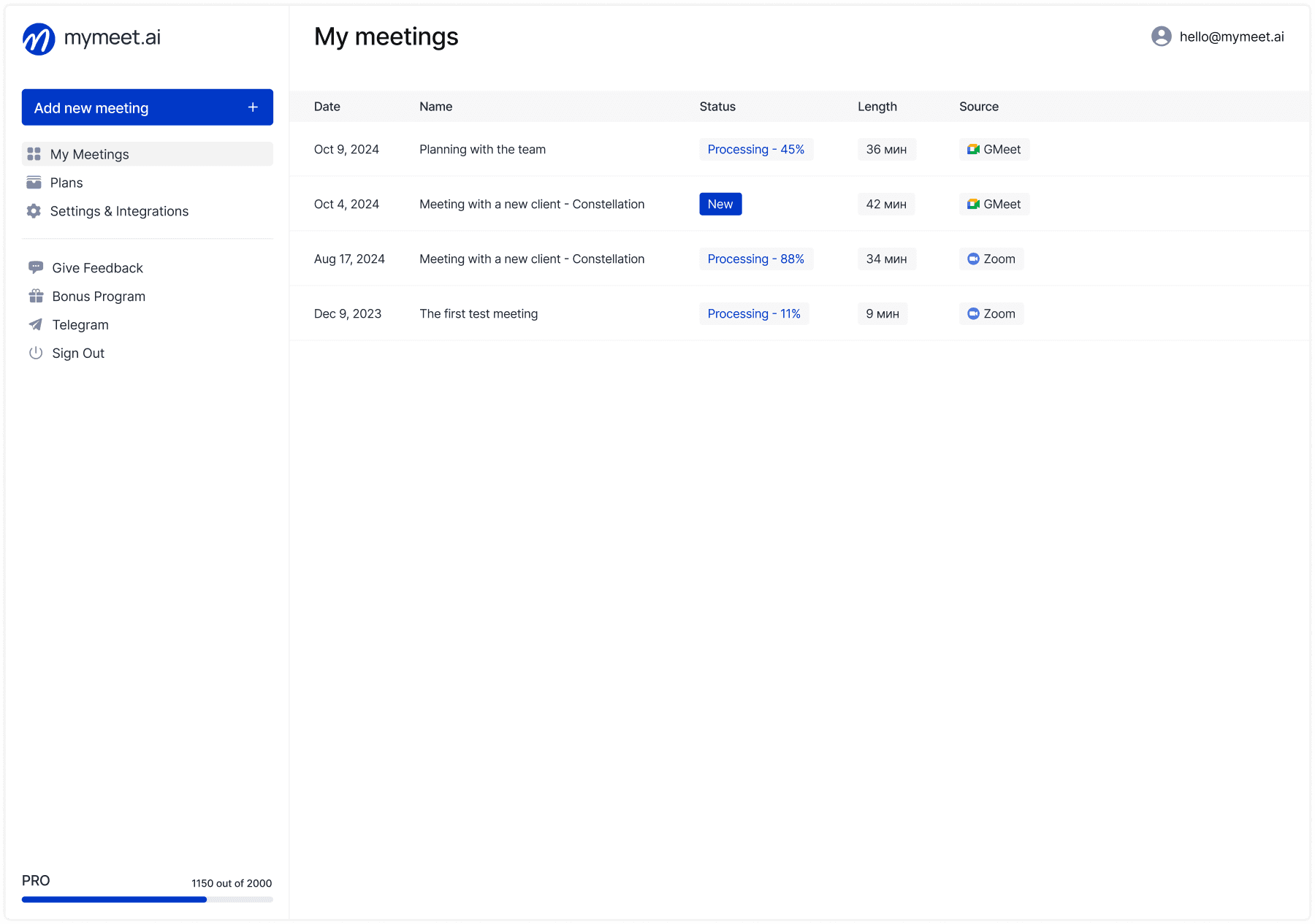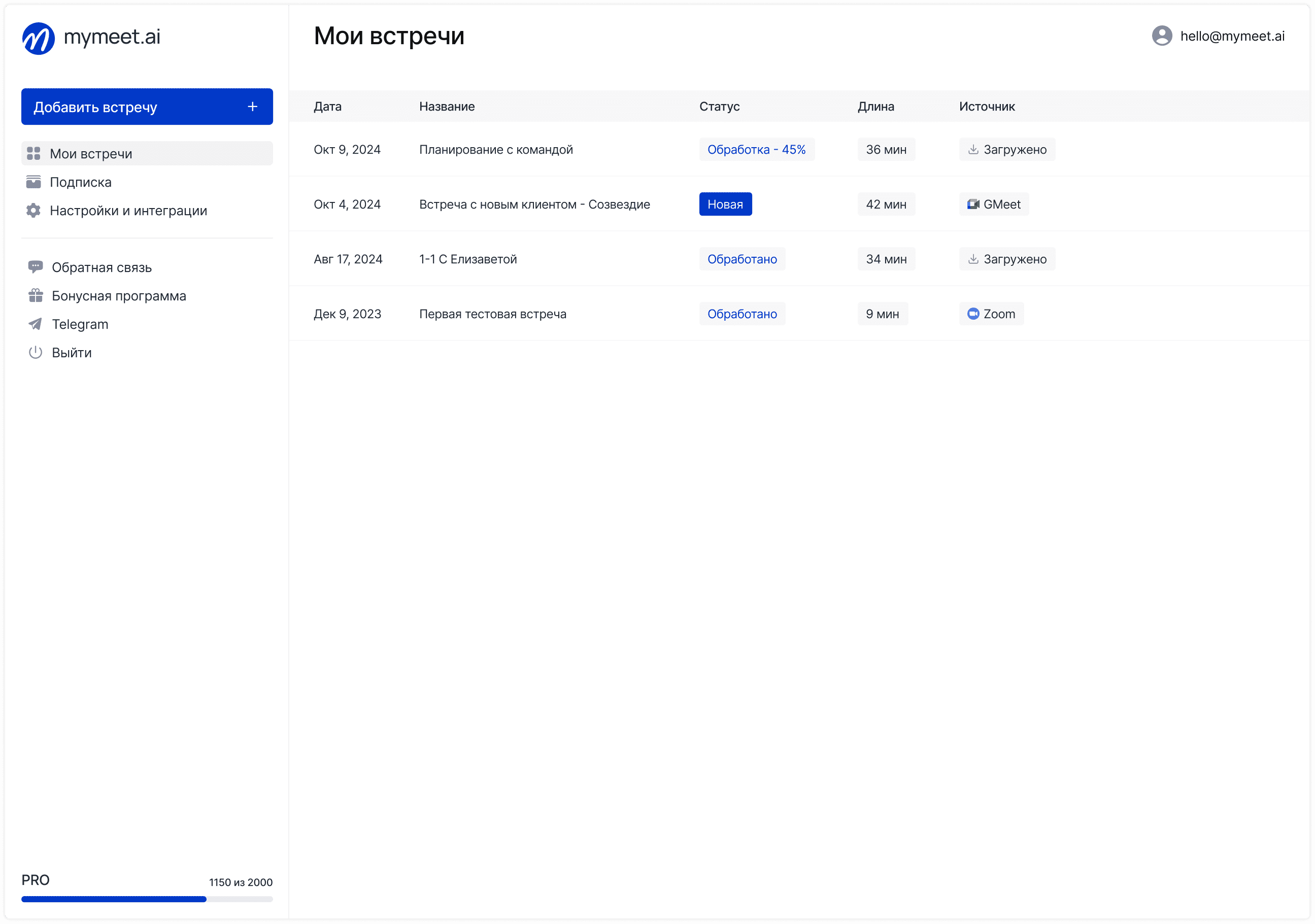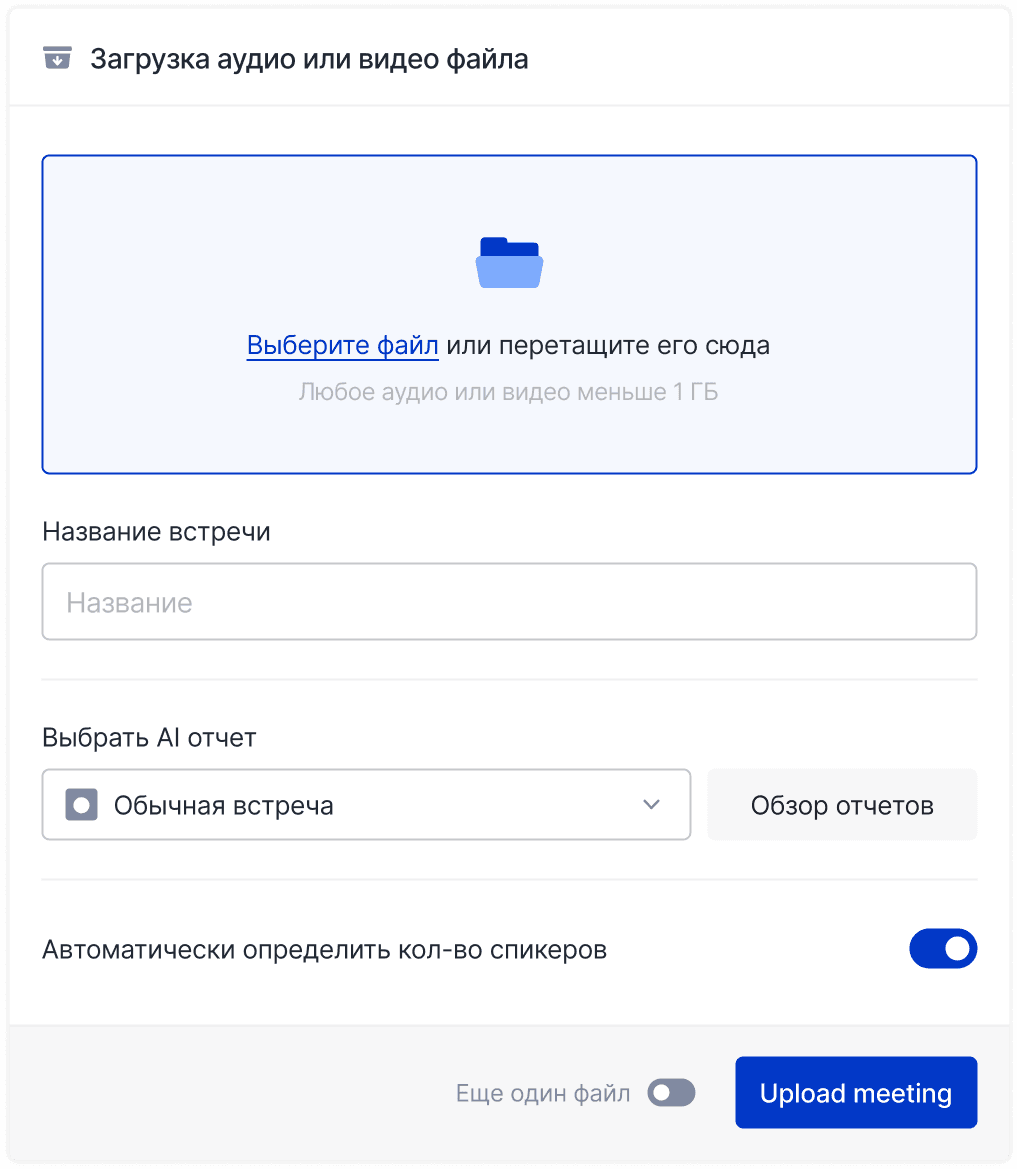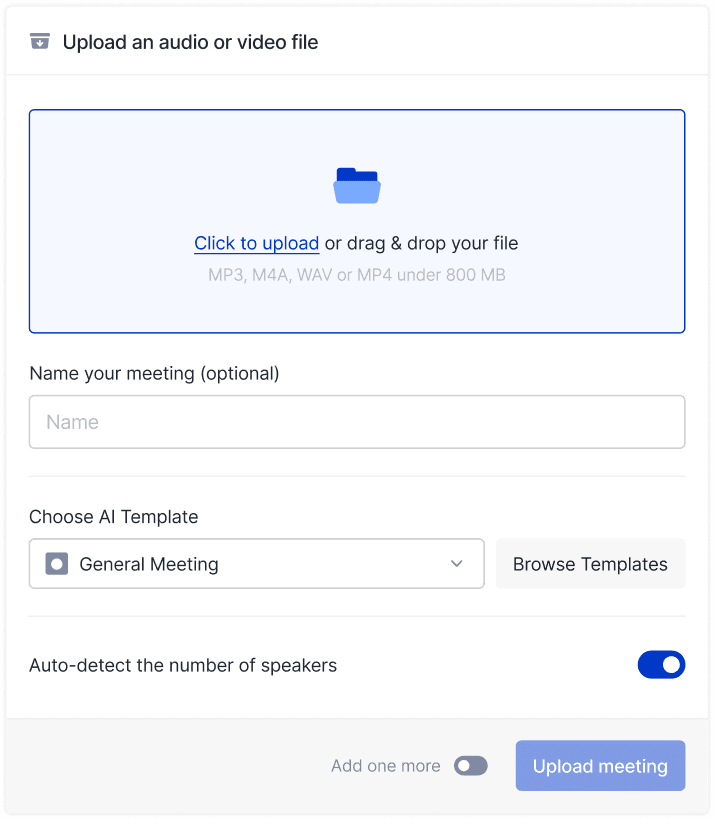Sales Mastery

Radzivon Alkhovik
Jul 16, 2025
The sales director at a major IT company faced a paradox: the department generated many leads and conducted dozens of meetings, but conversion to sales remained low. Analysis showed that the company was losing potential clients at every interaction stage due to the lack of a structured sales funnel. After building a systematic funnel with clear stages, transition criteria, and process automation, conversion doubled and the sales cycle shortened by a third.
The mymeet.ai team helps global B2B companies build effective sales funnels using modern analysis and automation technologies. A properly built sales funnel becomes the foundation for predictable growth and business scaling.
The B2B sales funnel fundamentally differs from B2C in cycle duration, number of decision-making process participants, and product complexity. Building an effective system requires deep understanding of the customer journey, clear stage structuring, and implementing processes that ensure lead movement through the funnel without losses.
What is a B2B Sales Funnel

A B2B sales funnel represents a structured process of converting potential customers into buyers through a sequence of interaction stages. Each stage has clear entry and exit criteria, defined activities, and measurable results.
Definition and Principles of B2B Sales Funnel
A B2B sales funnel is a systematized approach to managing the sales process that allows tracking progress of each potential client and forecasting results. Core principles include customer-centricity, process structure, and result measurability.
An effective B2B sales funnel is based on understanding the customer journey and is built around customer needs, not seller convenience. Each stage should bring value to the potential buyer and bring them closer to making a purchase decision.
Key principles for building an effective funnel:
Focus on real customer needs, not product characteristics
Clear transition criteria between stages with measurable indicators
Personalized approach to each target audience segment
Automation of routine processes to save team time
The funnel system ensures result predictability through analyzing conversions between stages and identifying bottlenecks.
Differences Between B2B and B2C Funnels
B2B sales funnels are characterized by significantly longer decision-making cycles, which can range from several months to a year. Multiple stakeholders with different roles and motivations participate in the process, requiring a personalized approach to each participant.
The complexity of B2B segment products requires an educational approach in early funnel stages. Potential clients must understand not only what they're buying, but also how it will solve their business problems and what return on investment they'll receive.
Key differences of B2B funnel from B2C:
Long decision-making cycle from 3 months to a year
Multiple purchase process participants with different roles
High cost of error when choosing a supplier
Need for technical integration and implementation
Focus on return on investment and business justification
The average deal size in B2B is significantly higher, justifying investments in personalized approach and long-term nurturing of potential clients.
Modern Trends in B2B Sales
Digitalization has fundamentally changed B2B buyer behavior. Research shows that clients independently complete a significant portion of the buyer's journey before first contact with a salesperson, studying information online and comparing solutions.
Communication personalization becomes critically important in conditions of information overload. B2B buyers expect relevant content that answers their specific questions and considers their business and industry specifics.
Multi-channel approach combines online and offline interactions to create seamless experience. Modern funnels integrate email marketing, social networks, content marketing, webinars, and personal meetings into a unified system. Artificial intelligence begins playing an important role in automating processes and personalizing interactions.
B2B Sales Funnel Stages
The B2B sales funnel structure includes sequential stages, each having specific goals, activities, and criteria for transitioning to the next level.
Funnel Stage | Main Goal | Key Activities | Average Conversion |
Attraction | Generate awareness | Content marketing, SEO, advertising | 2-5% to leads |
Lead Generation | Obtain contacts | Landing pages, forms, magnets | 15-25% to qualified leads |
Qualification | Assess potential | Discovery calls, BANT criteria | 20-40% to opportunities |
Presentation | Demonstrate value | Demos, pilots, case studies | 25-50% to negotiations |
Negotiation | Agree on terms | Commercial proposals, pricing | 15-30% to deals |
Closing | Sign contract | Legal formalization, final details | 70-90% success |
Attention Attraction and Lead Generation
The attraction stage focuses on creating awareness among the target audience and positioning the company as an expert. Content marketing, SEO optimization, and targeted advertising attract potential client attention when searching for solutions.
Effective lead attraction tools:
Expert materials and industry research
Free tools for solving business problems
Educational webinars and online events
Personalized audits and consultations
Lead quality is more important than quantity in the B2B segment — it's better to get fewer qualified contacts than many unsuitable ones.
Qualification and Nurturing Potential Clients
Lead qualification determines the readiness, ability, and authority of a potential client to make a purchase. BANT criteria (Budget, Authority, Need, Timeline) remain relevant but are supplemented by modern MEDDIC and SPICED approaches.
The nurturing process maintains relationships with clients who aren't ready to buy yet. Personalized content and regular touchpoints help develop relationships and prepare ground for future sales.
Solution Presentation and Objection Handling
The presentation stage requires deep understanding of client business problems and demonstrating how the product solves specific issues. Effective presentations focus on value proposition, not technical characteristics.
Pilot projects allow clients to evaluate the solution in real conditions. Objection handling requires a proactive approach — it's important to anticipate doubts and prepare convincing arguments in advance.
Deal Closing and Client Onboarding
The final stage includes negotiating terms and signing the contract. The process should be as simple as possible for the client, without unnecessary obstacles.
New client onboarding begins before contract signing and includes implementation planning and setting measurable goals. Analysis of closed and failed deals helps optimize the funnel and identify success factors.
Building an Effective B2B Sales Funnel
Creating a working funnel requires a systematic approach that includes target audience analysis, customer journey design, and implementing effectiveness measurement processes.
Target Audience Analysis and Customer Journey Mapping

Deep understanding of the target audience begins with creating detailed buyer personas that include demographic data, business problems, pain points, and decision-making processes. Each persona requires an individual approach and specific content.
Key elements of customer journey map:
First contact points with brand and product
Key decision-making moments in the purchase process
Customer emotional states at each stage
Barriers and objections preventing movement through the funnel
Opportunities for improving customer experience
Stage Design and Transition Criteria

Each funnel stage should have clear entry and exit criteria that help determine lead readiness to transition to the next level. Criteria are based on lead actions, characteristics, and engagement level.
Automation of routine processes frees up sales team time for strategic client work. Lead scoring and task management help optimize processes without losing quality.
Marketing and Sales Integration

Alignment between marketing and sales is critically important for funnel effectiveness. Common definitions of qualified leads and regular feedback cycles ensure seamless handoff between teams.
CRM system becomes the single source of data about leads and clients, ensuring visibility and collaboration between teams. Integration with marketing platforms creates a holistic view of the customer journey.
Key Sales Funnel Metrics
Measuring funnel effectiveness requires focus on key indicators that reflect sales process health and help identify optimization areas.
Conversions Between Funnel Stages

Stage-to-stage conversion shows process effectiveness and helps identify bottlenecks in the funnel. Significant conversion drops indicate problems in processes or lead quality at a specific stage.
Conversion analysis by lead sources helps optimize marketing budget and focus on most effective attraction channels. Comparison with industry standards helps understand company performance relative to the market.
Funnel Completion Time (Sales Velocity)

Sales velocity measures the speed of lead movement through the funnel and helps forecast results. Accelerating velocity increases revenue with the same number of leads entering the funnel.
Analysis of closing time by stages helps identify bottlenecks and optimize processes. Seasonal patterns affect sales velocity, requiring plan and forecast adjustments.
Customer Acquisition Cost and Lifetime Value

Customer acquisition cost includes all marketing and sales expenses divided by the number of acquired customers. Reducing cost while maintaining customer quality increases business profitability.
Customer lifetime value shows total value throughout the cooperation period. The ratio of lifetime value to acquisition cost should be at least 3:1 for sustainable B2B business.
Sales Funnel Optimization with Technology
Modern technologies fundamentally transform approaches to sales funnel management, providing new opportunities for automation, personalization, and analytics.
CRM Systems and Process Automation
CRM platforms provide centralized management of all customer interactions and automation of routine processes. Modern systems integrate with multiple communication channels and provide a unified view of the customer journey.
Funnel management functions help visualize the funnel, track deal progress, and forecast results. Workflow automation reduces administrative burden on the sales team and ensures process consistency.
Analytics and Sales Forecasting
Advanced analytics provides deep insights into funnel performance and helps make data-driven decisions. Predictive models use historical data to forecast deal closure probability.
Real-time dashboards provide visibility into current funnel state and allow quick response to changes. Cohort analysis shows performance of different lead groups and helps understand success factors.
Personalization and Artificial Intelligence in Sales
Artificial intelligence revolutionizes personalization in B2B sales through analyzing large volumes of data about customer behavior and preferences. AI-based recommendations help sales teams choose optimal next actions.
Dynamic content personalization adapts marketing materials to each lead's specifics. Chatbots and conversational AI automate initial qualification, ensuring 24/7 availability and instant responses.
mymeet.ai for B2B Sales Funnel Optimization

The mymeet.ai platform provides sales teams with powerful tools for analyzing and optimizing sales funnels through automating client interaction work.

Key mymeet.ai capabilities for sales funnel:
✅ Automatic sales meeting analysis — system identifies patterns of successful presentations and factors influencing customer decision-making
✅ Customer pain point identification — AI analyzes conversations and automatically determines key problems that can be solved with the product
✅ Objection analysis and handling — platform identifies typical customer objections and forms a base of effective responses

✅ Sales team coaching — objective assessment of presentation skills and personal recommendations for each manager
✅ CRM update automation — integration with leading CRM systems for automatic creation of detailed meeting reports
✅ Competitive environment analysis — identification of competitor mentions and analysis of comparative advantages

✅ Deal forecasting — AI determines closure probability based on communication analysis
✅ Enterprise-grade security compliance — secure processing of personal data with enterprise-level security standards
TechFlow Solutions Case: Sales Funnel Optimization
TechFlow Solutions uses mymeet.ai to analyze sales funnel effectiveness and identify success factors. Before implementation, the department head spent considerable time listening to meeting recordings to understand why some deals close while others don't.
With AI-based analysis, the company automatically identifies patterns of successful presentations, most effective arguments, and moments when clients make purchase decisions. This information is used for team training and approach standardization.
Objection analysis helped create a library of effective responses to typical customer questions. Managers received ready arguments for working with doubts and increased conversion at the presentation stage. Report automation reduced time on administrative tasks and allowed the team to focus on strategic client work.
Train employees to work with the AI assistant. Submit an application via the form for a corporate webinar.

Common Funnel Building Mistakes
Understanding typical mistakes helps avoid costly errors when designing and optimizing sales funnels.
Focus on Lead Quantity Instead of Quality
Many companies mistakenly believe that more leads automatically means more sales. However, low-quality leads create unnecessary burden on the sales team and reduce overall funnel effectiveness.
An effective funnel focuses on the ideal customer profile and generates fewer but more qualified leads. Qualification processes should be strict — it's better to reject an unsuitable lead early.
Lack of Clear Processes and Criteria
Vague transition criteria between stages lead to inconsistent funnel management and inaccurate forecasts. Managers differently interpret lead readiness for the next stage.
Documented processes and clear definitions ensure consistency and funnel scalability. Every team member should understand exactly what's needed to move a lead to the next stage.
Ignoring Customer Feedback
Companies often build funnels based on internal assumptions without considering real customer experience. This leads to gaps between processes and customer needs.
Regular feedback collection through surveys, interviews, and win/loss analysis provides valuable insights for optimization. Customer voice should be integrated into the funnel design process.
Conclusion
An effective B2B sales funnel becomes a competitive advantage in modern business. Companies that systematically approach funnel building and optimization achieve predictable growth and successfully scale sales.
A successful funnel requires deep understanding of the customer journey, clear process structuring, and continuous data-driven optimization. Integration of modern technologies, including CRM, marketing automation, and AI, significantly increases process effectiveness.
Global B2B companies have a unique opportunity to adapt best world practices to local market specifics, creating competitive advantages. Investments in professional sales funnels pay off through increased conversion rates, reduced sales cycles, and higher customer lifetime value.
Start optimizing your sales funnel today: use mymeet.ai to analyze your customer interactions and identify improvement opportunities. 180 minutes of free testing will show how AI can transform your sales processes and increase conversion at every funnel stage.
FAQ about B2B Sales Funnel
How many stages should a B2B sales funnel have?
The optimal number of stages depends on product complexity and sales cycle length. Usually 4-7 stages provide sufficient detail without excessive complexity. Clear criteria and measurable results at each stage are more important than stage count.
How to determine optimal sales funnel duration?
Average sales cycle duration depends on industry, deal size, and solution complexity. Analyze historical data from closed deals and identify factors affecting timeframes. Focus on acceleration, not artificial shortening.
What tools are necessary for building a funnel?
The basic set includes a CRM system, marketing automation platform, and analytics tools. Advanced companies use AI-based sales analytics systems, conversation analysis, and predictive modeling for process optimization.
How to measure sales funnel return on investment?
ROI is measured through increased conversion rates, reduced sales cycle duration, improved average deal size, and reduced customer acquisition costs. Tracking key metrics before and after optimization shows the impact of changes.
When should funnel structure be reviewed?
Regular reviews every 6-12 months or during significant changes in business model, target audience, or competitive environment. Market changes and customer behavior shifts require funnel adaptation.
How to integrate marketing and sales in the funnel?
Create common definitions of qualified leads, establish clear handoff processes, implement lead scoring models, and regular feedback cycles. Joint planning and shared goals ensure alignment between teams.
Which metrics are most important for a B2B funnel?
Key metrics include stage-to-stage conversion rates, sales velocity, funnel value, win rate, and customer acquisition cost. Focus on metrics that directly impact revenue and are controlled by the team.
How to automate funnel without losing personalization?
Use dynamic content, behavioral triggers, and AI-based personalization to scale personal approach. Automation should enhance human interactions, not replace them at critical customer journey moments.
What to do with leads stuck in the funnel?
Analyze stagnation reasons: lack of budget, missing stakeholders, competitive pressure. Develop re-engagement campaigns, provide additional value, and consider timeline adjustments. Sometimes it's better to disqualify than nurture indefinitely.
How to train a team to work with a new funnel?
The comprehensive training program includes process documentation, role-playing exercises, shadowing experienced specialists, and regular coaching sessions. Continuous education and feedback ensure successful implementation of new processes.
Radzivon Alkhovik
Jul 16, 2025







